Source: David C, Bankless; Translated by: Deng Tong, Jinse Finance
After the Ethereum Foundation recently announced the expansion of L1, Vitalik published an article titled "Simplifying L1" on Friday, elaborating on how Ethereum can simplify and strengthen its base layer to address long-term development.
For Vitalik, scalability is not enough - if Ethereum wants to be a "platform for storing and recording civilizational assets", it must also remain comprehensible, maintainable, and secure. He believes it is time to abandon the bloated architecture, rethink the core system, and replace the EVM with a simpler system. His goal is to build an Ethereum almost as simple as Bitcoin within five years.
Here is the tl;dr - covering the core ideas of simplifying consensus, execution, and more.
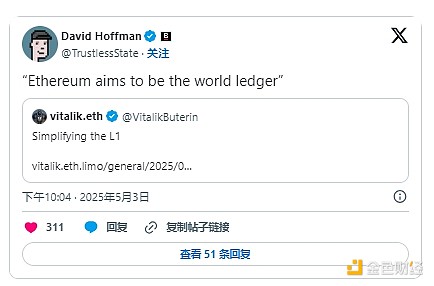
Why Simplicity Matters
For Vitalik, simplicity means more than just concise code; it's about making Ethereum more powerful. The more people who can understand and use the protocol, the more secure, decentralized, and adaptable it becomes.
He uses Bitcoin as an example: its base layer is extremely lean, to the point where a high school student (he believes) could build a client. This simplicity helped it maintain stability, broad auditability, and resistance to attacks.
In contrast, Ethereum has gradually accumulated complexity over time - sometimes necessarily, but often not. This complexity slows down upgrades, increases risks, and makes contributions more difficult.
Simplifying now will unlock key advantages:
Easier to Verify and Secure: Less code means fewer potential vulnerabilities or attack surfaces.
Lower Maintenance Burden: Fewer legacy systems make future upgrades smoother.
Broader Contributor Base: Simpler design can attract more developers.
Stronger Neutrality: Clear, predictable rules are harder to manipulate or politicize.
As the network stabilizes and matures, Vitalik believes now is the time to clean up redundancies.
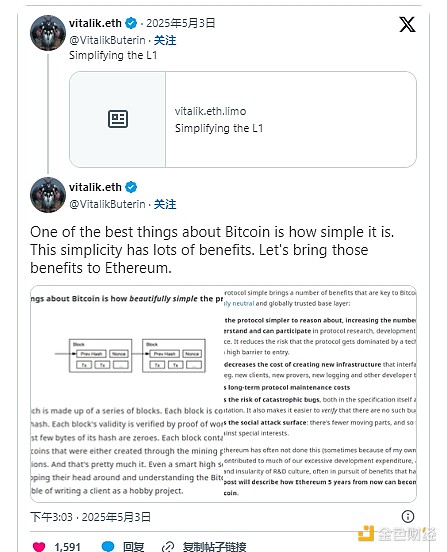
1. Simpler Consensus Layer
To simplify consensus, Buterin points to the new Beam Chain proposal, which advocates replacing old, complex systems with a more concise design:
More Streamlined Core with Three-Slot Finality: Eliminating technical systems like epochs, committee reshuffling, and sync committees, making the consensus engine easier to understand, audit, and maintain.
Simpler Fork Choice Rule: Reducing the number of active validators at any moment, lowering the complexity of deciding which chain version to follow, and improving security.
Simpler Vote Collection (STARK-based): Making it easier and more economical to collect validator votes without trusting specific participants or handling duplicate data.
Clearer Validator Lifecycle: Making validator entry, exit, key updates, and offline recovery more direct, reducing edge cases, and helping the network define clearer security windows.
Simplified Peer-to-Peer Communication: Fewer protocol components make nodes easier to connect, synchronize, and stay consistent.
2. Simpler Execution Layer
Vitalik reaffirms support for replacing Ethereum's current virtual machine EVM with a simpler, more modern RISC-V alternative, which he sees as bloated and hindering scalability.
For those who missed our article about RISC-V, this universal virtual machine can be seen as a hardware version of Linux: a concise open-source blueprint already used by companies like Intel and Arm. In Ethereum, it will serve as the new smart contract engine, offering the following advantages:
Simpler Virtual Machine Specification: Easier to understand than EVM, reducing errors, making upgrades more convenient, and better suited for long-term maintenance.
Fewer Special Case Shortcuts (Pre-compiles): Replacing most built-in functions with regular smart contract code, streamlining the base protocol and making it easier to maintain.
Already Used in ZK: Since RISC-V accelerates zero-knowledge proofs, it has been adopted by projects like Polygon, Risc Zero, and SP1.
More Flexible Languages: Developers can use languages like Rust or Move, not just Solidity.
Vitalik sees this as an opportunity to rebuild the foundation better, potentially improving performance by 100 times.
3. Backward Compatible Transition
What about applications and tools still relying on EVM? Vitalik has developed a phased transition plan aimed at keeping everything running without letting the base protocol permanently carry legacy baggage.
The goal is to move legacy features out of the core protocol while keeping them valid. It's like storing old files in the cloud - still available if needed, but not cluttering your desktop. This can maintain the core protocol's leanness while preserving compatibility with all existing builds. His suggested approach is as follows:
Start with RISC-V Pre-compiles: New features will be built using RISC-V, helping the ecosystem better adapt to the virtual machine.
Support Two Virtual Machines: During the transition, developers can deploy in either EVM or RISC-V, achieving full cross-compatibility.
Replace Pre-compiled Code with RISC-V Code: Replacing most built-in functions with simple on-chain RISC-V code, reducing protocol bloat.
Encapsulate EVM in a Contract: Migrating EVM to a RISC-V smart contract, meaning old logic can still run without interfering with the protocol's most sensitive parts.
This way, Ethereum can clean up its foundation without breaking what has already been built.
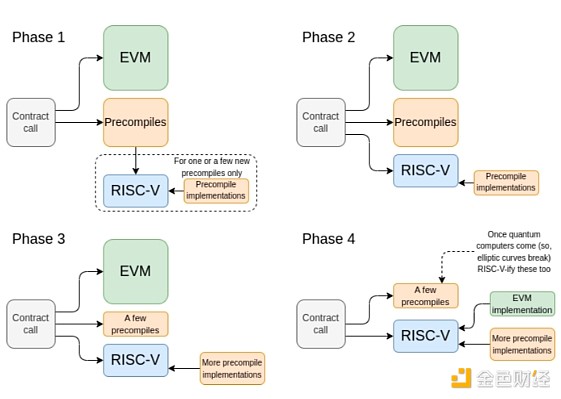
4. Shared Standards = Reduced Complexity
Finally, Vitalik wants to simplify Ethereum by standardizing tools across the network.
Currently, different parts of the protocol often solve the same problem slightly differently - mainly because each team builds them independently. Unifying these parts under shared standards can reduce complexity and make the entire stack easier to maintain. His suggestions are:
Unified Shared Encoding System (SSZ): Already used in the consensus layer to track network state. Extending it across Ethereum will simplify tools and make applications easier to build and connect.
Unified Data Splitting Method (Erasure Coding): Ethereum splits and validates data in multiple ways: data availability sampling, P2P broadcasting, and historical storage. Using the same method everywhere can reduce code volume, improve speed, and ensure data verification accuracy.
Unified State Structure (Tree Structure): Replacing the current complex Merkle data trees with a simpler binary data tree can save space, speed up proofs, and help lightweight applications run more efficiently.
These small changes might not sound groundbreaking, but they reduce the system's overall weight - making Ethereum easier to run and harder to break.
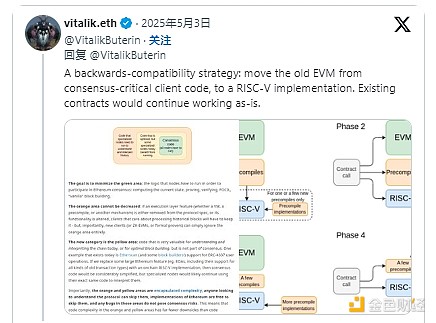
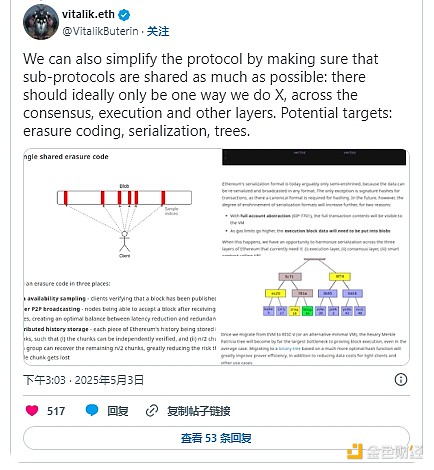
In summary, Ethereum's advantage has always been flexibility - but this also comes with increasing complexity.
Vitalik's vision aims to reclaim simplicity while maintaining powerful functionality, making Ethereum more streamlined, clearer, and easier to build upon. If Ethereum wants to support the world's most important data and systems, it needs not only scalability but also durability.
Vitalik believes that to achieve this, simplification must come first.







